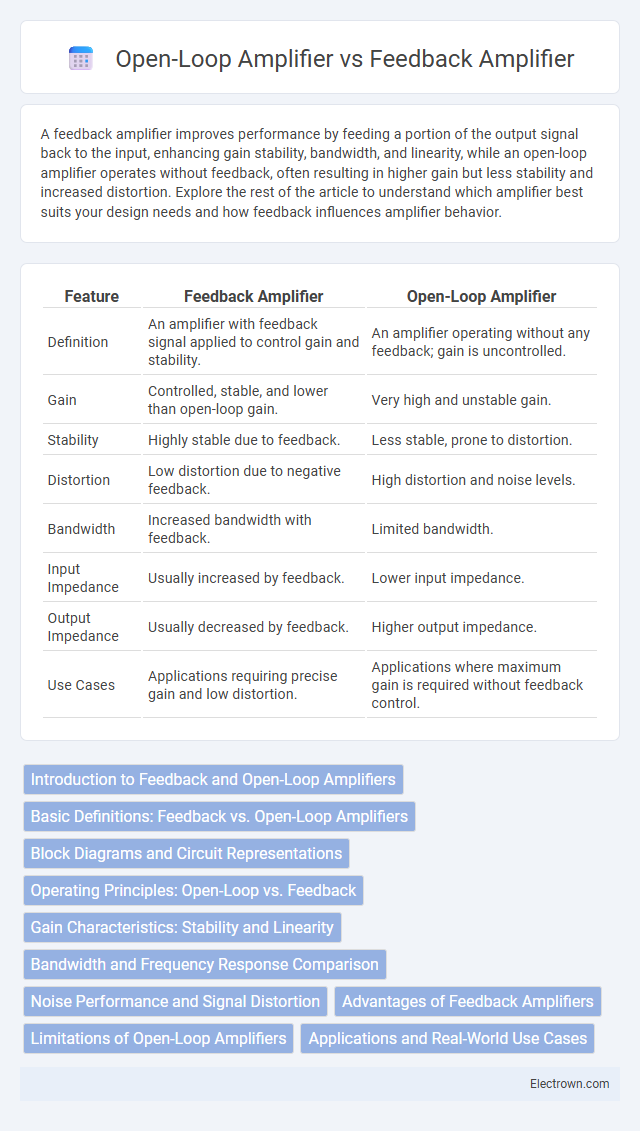A feedback amplifier improves performance by feeding a portion of the output signal back to the input, enhancing gain stability, bandwidth, and linearity, while an open-loop amplifier operates without feedback, often resulting in higher gain but less stability and increased distortion. Explore the rest of the article to understand which amplifier best suits your design needs and how feedback influences amplifier behavior.
Table of Comparison
| Feature | Feedback Amplifier | Open-Loop Amplifier |
|---|---|---|
| Definition | An amplifier with feedback signal applied to control gain and stability. | An amplifier operating without any feedback; gain is uncontrolled. |
| Gain | Controlled, stable, and lower than open-loop gain. | Very high and unstable gain. |
| Stability | Highly stable due to feedback. | Less stable, prone to distortion. |
| Distortion | Low distortion due to negative feedback. | High distortion and noise levels. |
| Bandwidth | Increased bandwidth with feedback. | Limited bandwidth. |
| Input Impedance | Usually increased by feedback. | Lower input impedance. |
| Output Impedance | Usually decreased by feedback. | Higher output impedance. |
| Use Cases | Applications requiring precise gain and low distortion. | Applications where maximum gain is required without feedback control. |
Introduction to Feedback and Open-Loop Amplifiers
Feedback amplifiers incorporate a portion of the output signal back to the input, improving stability, bandwidth, and linearity compared to open-loop amplifiers, which operate without such signal recycling. Open-loop amplifiers typically have very high gain but suffer from distortion and instability due to the lack of control over the output. Understanding the differences between these two amplifier types helps you design circuits with improved performance by leveraging feedback control mechanisms.
Basic Definitions: Feedback vs. Open-Loop Amplifiers
A feedback amplifier incorporates a portion of its output signal back into the input to stabilize gain, improve linearity, and reduce distortion, enhancing overall performance and bandwidth. An open-loop amplifier operates without any feedback, resulting in maximum gain but with less stability, higher distortion, and limited bandwidth. Understanding these fundamental differences is crucial for selecting the appropriate amplifier type based on system requirements for precision, gain control, and signal integrity.
Block Diagrams and Circuit Representations
Feedback amplifiers incorporate a portion of the output signal back into the input through a feedback network, represented in block diagrams by a forward gain block combined with a feedback path and summing junction. Open-loop amplifiers lack the feedback path, featuring only a single forward gain block in block diagrams, leading to higher gain but lower stability. Circuit representations of feedback amplifiers display components such as resistors or networks connecting output to input, whereas open-loop amplifiers are depicted without these feedback elements, reflecting straightforward amplification stages.
Operating Principles: Open-Loop vs. Feedback
Open-loop amplifiers operate by directly amplifying the input signal without any correction, resulting in high gain but poor stability and linearity. Feedback amplifiers incorporate a portion of the output signal back to the input, which stabilizes the gain, reduces distortion, and improves bandwidth. The feedback mechanism enhances control over operating parameters, making feedback amplifiers preferable for precision applications.
Gain Characteristics: Stability and Linearity
Feedback amplifiers exhibit improved gain stability and enhanced linearity compared to open-loop amplifiers by incorporating a portion of the output signal back to the input, reducing distortion and sensitivity to component variations. Open-loop amplifiers have high gain but suffer from significant instability and non-linearity due to the absence of corrective feedback, making them less reliable in precision applications. Your choice between these amplifiers should consider the trade-off between maximum gain and the need for consistent, linear performance under varying conditions.
Bandwidth and Frequency Response Comparison
Feedback amplifiers exhibit a wider bandwidth and more stable frequency response compared to open-loop amplifiers due to the negative feedback reducing gain at low frequencies while extending high-frequency roll-off. Open-loop amplifiers typically have higher gain but suffer from narrower bandwidth and less predictable frequency response, often leading to distortion and instability at higher frequencies. The application of feedback creates a trade-off, improving linearity and bandwidth performance by sacrificing some gain.
Noise Performance and Signal Distortion
Feedback amplifiers significantly reduce noise levels by actively correcting output deviations, enhancing signal integrity compared to open-loop amplifiers, which amplify noise along with the signal. Signal distortion is minimized in feedback amplifiers through automatic error correction, resulting in a more linear response, whereas open-loop amplifiers often exhibit higher distortion due to lack of feedback control. Your choice of amplifier impacts overall system performance, with feedback amplifiers offering superior noise suppression and reduced harmonic distortion for cleaner amplification.
Advantages of Feedback Amplifiers
Feedback amplifiers offer superior stability and reduced distortion by continuously correcting the output signal based on the input, enhancing overall signal fidelity. They provide improved bandwidth and gain accuracy compared to open-loop amplifiers, ensuring consistent performance across varying operating conditions. Your circuit benefits from lowered sensitivity to component variations and noise, resulting in more reliable and predictable amplification.
Limitations of Open-Loop Amplifiers
Open-loop amplifiers suffer from significant limitations including high gain variability due to temperature changes and manufacturing inconsistencies, resulting in poor accuracy and stability. They exhibit a limited bandwidth and are prone to distortion and noise amplification, which degrade signal quality in practical applications. Feedback amplifiers overcome these issues by stabilizing gain, improving linearity, reducing distortion, and extending bandwidth, making them more suitable for precision and high-performance circuits.
Applications and Real-World Use Cases
Feedback amplifiers are extensively used in audio equipment, instrumentation, and control systems due to their ability to maintain stable gain and reduce distortion, making them ideal for applications requiring precision and reliability. Open-loop amplifiers find applications mainly in specific sensor interfaces and operational amplifier building blocks where maximum gain is necessary without feedback-induced phase shifts. Your choice depends on whether stability and linearity or maximum gain are prioritized in the real-world application.
Feedback amplifier vs open-loop amplifier Infographic

 electrown.com
electrown.com